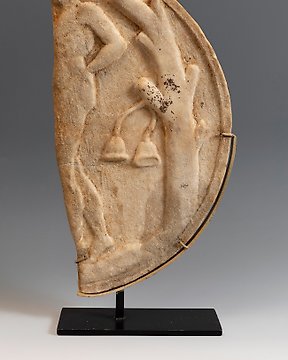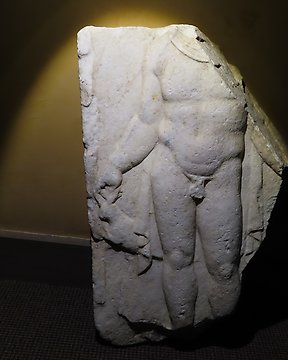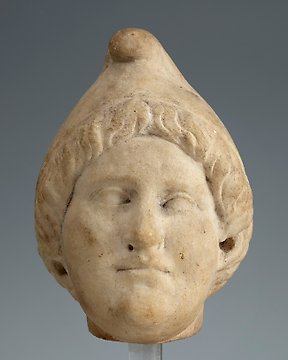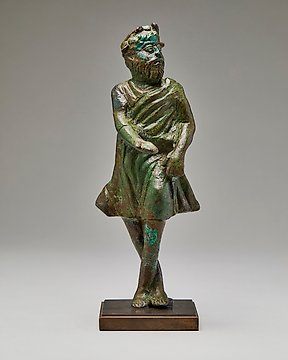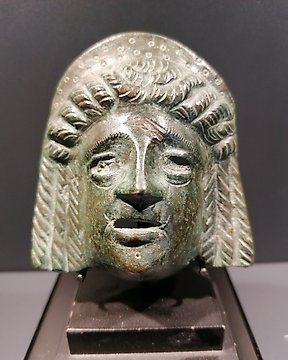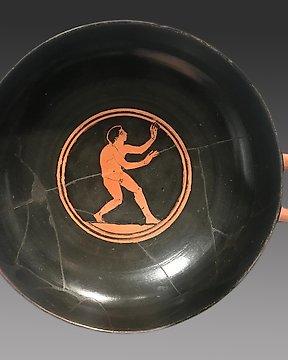Todo perfecto, envío, comunicación y artículo
查看翻譯古羅馬 大理石 薩特的頭。西元一至三世紀。 30 公分高。西班牙出口許可證。
編號 85665297



Head of a Satyr
- refined style -
Roman Empire, 1st - 3rd century AD
MATERIAL: Marble.
DIMENSIONS: 30 cm height with stand, 17 cm height without stand.
PROVENANCE: Private collection, Berlin, Germany. Old collection before 2nd world war.
CONDITION: Good conditon, not restored.
DESCRIPTION:
Roman head made in marble representing a satyr, which can be deduced from the treatment of the hair, through the somewhat anarchic-looking curls (although, due to erosion, part of this disorderly representation of the locks has been lost) and, above all, the large mouth, insinuating a sardonic smile, which are common characteristics in the representation of this mythological character. The carver combines idealism and realism, a fact that was common in Roman statuary. The hair, the treatment of the eyes, and the strict symmetry bring us closer to this idealism that sought to represent harmony. However, the protruding lips and cheekbones show an almost animalistic expressiveness.
Related to the Maenads, the satyrs form the 'Dionysian retinue' that accompanies the god Dionysus. They are depicted in various forms; the most common (and basically Roman) is that of a half-man half-ram creature, with pointed ears and horns on the head, abundant hair, a flat nose, a goat's tail and a permanent priapism. One tradition considered the sons of Silenus, named Maron, Leneus and Astreo, to have been the fathers of the satyrs. All three were in the retinue of Dionysus when he travelled to India and, in fact, Astreo was the driver of his chariot. As we can see in this Roman sculpture, satyrs are cheerful and mischievous creatures, although their lighthearted and festive nature can turn dangerous and even violent (which explains why our sculpture has a frown on its face). As Dionysian creatures, they are lovers of wine and enjoy carnal pleasures.
Satyr and Silenus, in Greek mythology, creatures of the wild, part man and part beast, who in Classical times were closely associated with the god Dionysus. Their Italian counterparts were the Fauns (see Faunus). Satyrs and Sileni were at first represented as uncouth men, each with a horse’s tail and ears and an erect phallus. In the Hellenistic age they were represented as men having a goat’s legs and tail. The occurrence of two different names for the creatures has been explained by two rival theories: that Silenus was the Asian Greek and Satyr the mainland name for the same mythical being; or that the Sileni were part horse and the Satyrs part goat. Neither theory, however, fits all the examples in early art and literature. From the 5th century BC the name Silenus was applied to Dionysus’ foster father, which thus aided the gradual absorption of the Satyrs and Sileni into the Dionysiac cult. In the Great Dionysia festival at Athens three tragedies were followed by a Satyr play (e.g., Euripides’ Cyclops), in which the chorus was dressed to represent Satyrs. Silenus, although bibulous like the Satyrs in the Satyr plays, also appeared in legend as a dispenser of homely wisdom.
In art the Satyrs and Sileni were depicted in company with nymphs or Maenads whom they pursued. (Their amorous relations with nymphs are described as early as the Homeric Hymn to Aphrodite.) The Greek sculptor Praxiteles represented a new artistic type in which the Satyr was young and handsome, with only the smallest vestiges of animal parts. Hellenistic artists developed that concept into humorous or forceful representation of half-animal subjects as an escape from the merely human.
Notes:
The seller guarantees that he acquired this piece according to all national and international laws related to the ownership of cultural property. Provenance statement seen by Catawiki.
The seller will take care that any necessary permits, like an export license will be arranged, he will inform the buyer about the status of it if this takes more than a few days.
The piece includes authenticity certificate.
The piece includes Spanish Export License.
#historyroom
賣家的故事
Head of a Satyr
- refined style -
Roman Empire, 1st - 3rd century AD
MATERIAL: Marble.
DIMENSIONS: 30 cm height with stand, 17 cm height without stand.
PROVENANCE: Private collection, Berlin, Germany. Old collection before 2nd world war.
CONDITION: Good conditon, not restored.
DESCRIPTION:
Roman head made in marble representing a satyr, which can be deduced from the treatment of the hair, through the somewhat anarchic-looking curls (although, due to erosion, part of this disorderly representation of the locks has been lost) and, above all, the large mouth, insinuating a sardonic smile, which are common characteristics in the representation of this mythological character. The carver combines idealism and realism, a fact that was common in Roman statuary. The hair, the treatment of the eyes, and the strict symmetry bring us closer to this idealism that sought to represent harmony. However, the protruding lips and cheekbones show an almost animalistic expressiveness.
Related to the Maenads, the satyrs form the 'Dionysian retinue' that accompanies the god Dionysus. They are depicted in various forms; the most common (and basically Roman) is that of a half-man half-ram creature, with pointed ears and horns on the head, abundant hair, a flat nose, a goat's tail and a permanent priapism. One tradition considered the sons of Silenus, named Maron, Leneus and Astreo, to have been the fathers of the satyrs. All three were in the retinue of Dionysus when he travelled to India and, in fact, Astreo was the driver of his chariot. As we can see in this Roman sculpture, satyrs are cheerful and mischievous creatures, although their lighthearted and festive nature can turn dangerous and even violent (which explains why our sculpture has a frown on its face). As Dionysian creatures, they are lovers of wine and enjoy carnal pleasures.
Satyr and Silenus, in Greek mythology, creatures of the wild, part man and part beast, who in Classical times were closely associated with the god Dionysus. Their Italian counterparts were the Fauns (see Faunus). Satyrs and Sileni were at first represented as uncouth men, each with a horse’s tail and ears and an erect phallus. In the Hellenistic age they were represented as men having a goat’s legs and tail. The occurrence of two different names for the creatures has been explained by two rival theories: that Silenus was the Asian Greek and Satyr the mainland name for the same mythical being; or that the Sileni were part horse and the Satyrs part goat. Neither theory, however, fits all the examples in early art and literature. From the 5th century BC the name Silenus was applied to Dionysus’ foster father, which thus aided the gradual absorption of the Satyrs and Sileni into the Dionysiac cult. In the Great Dionysia festival at Athens three tragedies were followed by a Satyr play (e.g., Euripides’ Cyclops), in which the chorus was dressed to represent Satyrs. Silenus, although bibulous like the Satyrs in the Satyr plays, also appeared in legend as a dispenser of homely wisdom.
In art the Satyrs and Sileni were depicted in company with nymphs or Maenads whom they pursued. (Their amorous relations with nymphs are described as early as the Homeric Hymn to Aphrodite.) The Greek sculptor Praxiteles represented a new artistic type in which the Satyr was young and handsome, with only the smallest vestiges of animal parts. Hellenistic artists developed that concept into humorous or forceful representation of half-animal subjects as an escape from the merely human.
Notes:
The seller guarantees that he acquired this piece according to all national and international laws related to the ownership of cultural property. Provenance statement seen by Catawiki.
The seller will take care that any necessary permits, like an export license will be arranged, he will inform the buyer about the status of it if this takes more than a few days.
The piece includes authenticity certificate.
The piece includes Spanish Export License.
#historyroom
賣家的故事
- 757
- 7
- 0
bellissimo, orientale e ben recapitato....
查看翻譯Thank you.
查看翻譯Ha llegado en perfectas condiciones, tal y como se muestra en las fotos. Muchas gracias.
查看翻譯Beautiful little treasure of the ancient world? Delivered in due time! Thanks!
查看翻譯top come sempre 💯
查看翻譯Je suis très satisfait du produit il est très jolie et correspond au descriptif les documents demandés sont fournis Seul bémol !!le support fourni n'est pas le bon trop grand 🙄 sinon tout OK
查看翻譯BEL OBJET ANCIEN DE QUALITE BIEN EMBALLE ET ACHEMINE
查看翻譯Todo correcto. Gracias
查看翻譯Très beaux objets!!! Livraison rapide et soignée. Meeci👏🏻
查看翻譯Top vendeur
查看翻譯El objeto tenia algunos problemas que fueron solucionados por la empresa, labor excelente y pocas veces vista en este tipo de transacciones. Mis felicitaciones a la empresa
查看翻譯Fast delivery, object fine. However, bad carrier: please never use again DHL express as they are "DHL slow": instead of coming to my address, they put it directly to a DHL Service Point/Locker.
查看翻譯Todo correcto
查看翻譯I am very happy with the ancient bronze horse. Excellent that it was delivered within a few days. My compliments to J.Bagot Arqueologia- Ancient Art, well done! Ron van Schaick
查看翻譯Perfect transaction and fantastic item. Thank you.
查看翻譯conforme rapide hope other thanks ++++
查看翻譯Különleges eszköz, jó állapotban van, köszönöm a rendkívül gyors szállítást. Ajánlom az Eladót!
查看翻譯fast delivery, good packaging
查看翻譯Good seller: fast shipment, good packing and a very nice object. Thank you!
查看翻譯super 💯💯💯💯💯
查看翻譯Il pezzo è arrivato in condizioni perfette il pacco era protetto alla perfezione
查看翻譯Buenos días, señor. ¡Gracias por las precauciones de embalaje Tip / Top! Muy contento con mi compra. ¡Gracias!
查看翻譯Perfecto! :)
查看翻譯Wunderbares Stück. Alles wie beschrieben. Hervorragender Kontakt.
查看翻譯免責聲明
賣家保證並能證明該物品是合法取得的。 Catawiki 通知賣家,他們必須提供其居住國法律要求的文件。 賣家保證並有權出售/出口此物品。 賣家將向買家提供有關該物品的所有已知來源的資訊。 賣家確保已/將安排任何必要的許可證明。 賣家將立即通知買家有關獲得此類許可時的任何延誤。
賣家保證並能證明該物品是合法取得的。 Catawiki 通知賣家,他們必須提供其居住國法律要求的文件。 賣家保證並有權出售/出口此物品。 賣家將向買家提供有關該物品的所有已知來源的資訊。 賣家確保已/將安排任何必要的許可證明。 賣家將立即通知買家有關獲得此類許可時的任何延誤。
